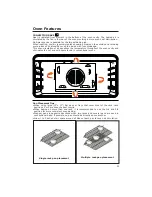
20
HOB GAS BURNER KNOB (FIG. 9)
Lighting Burners
All burners are ignited by electric ignition.
There are no open-flame, “standing” pilots.
Work-top Burners
To light the surface burners, push and turn the appropriate control knob anticlockwise
to maximum flow position
. This control is both a gas valve and an electric switch.
When gas is permitted to flow to the burners, the electric igniters start sparking.
On all surface igniters you should hear a “clicking” sound. If you do not, turn off the
control and check that the unit is plugged in and that the fuse or circuit breaker is not
blown or tripped.
Within a few moments, enough gas will have traveled to the burner to light. When the
burner lights, turn the burner control to any position from maximum
to minimum
flow position to adjust the flame size. Setting the proper flame height for the
desired cooking process and selecting the correct cooking vessel will result in superior
cooking performance, while also saving time and energy.
SURFACE COOKING TIPS
Use low or medium flame heights when cooking in vessels that are poor conductors
of heat, such as glass, ceramic, and cast-iron. Reduce the flame height until it covers
approximately 1/3 of the cooking vessel diameter. This will ensure more even heating
within the cooking vessel and reduce the likelihood of burning or scorching the food.
• Reduce the flame if it is extending beyond the bottom of the cooking vessel. A flame
that extends along the sides of the vessel is potentially dangerous, heats the utensil
handle and kitchen instead of the food, and wastes energy.
• The minimum pot or pan (vessel) diameter recommended is 6” (15 cm) on the larger
burners. Pots or pans as small as 4” (10 cm) should be used on the smaller burners.
Description of the controls













































